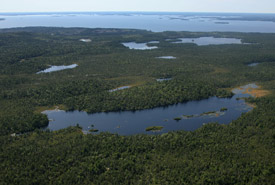Deep Cove

Deep Cove, Nova Scotia (Photo by Mike Dembeck)
Deep Cove is a remarkable tapestry of mature forest, bogs, fens, shrub barrens and small lakes. The Nature Conservancy of Canada's (NCC's) conservation areas here feature possibly the largest stand of jack pine in the province, a thriving forested bog and rare lichens. Together they form a vast ecological corridor that functions to maintain the health of local ecosystems and foster regional biodiversity.
Deep Cove at a glance
- NCC's Deep Cove properties, totalling 339 hectares (838 acres), border Hollahan Lake on Nova Scotia's South Shore, about 60 kilometres southwest of Halifax.
- The Deep Cove properties are an untouched wilderness that have kept some of Nova Scotia's rarest species safe from extinction.
- In addition to preserving large stands of fir, white and jack pine trees, rare lichens and excellent amphibian habitat, the bog at Deep Cove also works to purify local groundwater.
Conservation values
Deep Cove shelters:
- excellent habitat for globally endangered boreal felt lichen;
- the fifth-known location in Nova Scotia for powdered moon lichen;
- heath-dominated barrens support the provincially imperiled mountain sandwort;
- the site is home to a very rare lichen related to the boreal felt lichen (vole ear's lichen).
Through continued stewardship, we hope to maintain the incredible biodiversity found within the property's borders.
Threats
Escalating land prices, damage from motorized vehicles, and timber harvesting are concerns surrounding NCC's Deep Cove properties. Scientific assessments have indicated it is a sensitive area where conservation is key.
Conservation status
Our efforts have secured a wide corridor of habitat, thus protecting Deep Cove from the factors that may compromise other properties in the area.
Our vision
Prior to NCC's acquisition of these properties, forest harvesting impacted nearly eight per-cent of the total area. Through careful management, we hope to strengthen the diversity and health of the region so it will be sustained for decades.





